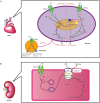Detrimental or beneficial: the role of TRPM2 in ischemia/reperfusion injury
- PMID: 26725732
- PMCID: PMC4722978
- DOI: 10.1038/aps.2015.141
Detrimental or beneficial: the role of TRPM2 in ischemia/reperfusion injury
Abstract
Ischemia/reperfusion (I/R) injury is the main cause of tissue damage and dysfunction. I/R injury is characterized by Ca(2+) overload and production of reactive oxygen species (ROS), which play critical roles in the process of I/R injury to the brain, heart and kidney, but the underlying mechanisms are largely elusive. Recent evidence demonstrates that TRPM2, a Ca(2+)-permeable cationic channel and ROS sensor, is involved in I/R injury, but whether TRPM2 plays a protective or detrimental role in this process remains controversial. In this review, we discuss the recent progress in understanding the role of TRPM2 in reperfusion process after brain, heart and kidney ischemia and the potential of targeting TRPM2 for the development of therapeutic drugs to treat I/R injury.
Figures



Similar articles
-
Deficiency of ROS-Activated TRPM2 Channel Protects Neurons from Cerebral Ischemia-Reperfusion Injury through Upregulating Autophagy.Oxid Med Cell Longev. 2021 Jul 27;2021:7356266. doi: 10.1155/2021/7356266. eCollection 2021. Oxid Med Cell Longev. 2021. PMID: 34367466 Free PMC article.
-
TRPM2 protects against tissue damage following oxidative stress and ischaemia-reperfusion.J Physiol. 2016 Aug 1;594(15):4181-91. doi: 10.1113/JP270934. Epub 2015 Nov 11. J Physiol. 2016. PMID: 26420388 Free PMC article. Review.
-
Neutrophil TRPM2 channels are implicated in the exacerbation of myocardial ischaemia/reperfusion injury.Cardiovasc Res. 2013 Feb 1;97(2):271-81. doi: 10.1093/cvr/cvs332. Epub 2012 Nov 5. Cardiovasc Res. 2013. PMID: 23129587
-
Pathological Mechanisms Induced by TRPM2 Ion Channels Activation in Renal Ischemia-Reperfusion Injury.Mol Biol Rep. 2022 Nov;49(11):11071-11079. doi: 10.1007/s11033-022-07836-w. Epub 2022 Sep 14. Mol Biol Rep. 2022. PMID: 36104583 Review.
-
Bidirectional regulation mechanism of TRPM2 channel: role in oxidative stress, inflammation and ischemia-reperfusion injury.Front Immunol. 2024 Jun 28;15:1391355. doi: 10.3389/fimmu.2024.1391355. eCollection 2024. Front Immunol. 2024. PMID: 39007141 Free PMC article. Review.
Cited by
-
Promising Antioxidative Effect of Berberine in Cardiovascular Diseases.Front Pharmacol. 2022 Mar 7;13:865353. doi: 10.3389/fphar.2022.865353. eCollection 2022. Front Pharmacol. 2022. PMID: 35321323 Free PMC article. Review.
-
ROS-Mediated NLRP3 Inflammasome Activation in Brain, Heart, Kidney, and Testis Ischemia/Reperfusion Injury.Oxid Med Cell Longev. 2016;2016:2183026. doi: 10.1155/2016/2183026. Epub 2016 Apr 5. Oxid Med Cell Longev. 2016. PMID: 27127546 Free PMC article. Review.
-
Research Progress on the Role of Pyroptosis in Myocardial Ischemia-Reperfusion Injury.Cells. 2022 Oct 18;11(20):3271. doi: 10.3390/cells11203271. Cells. 2022. PMID: 36291138 Free PMC article. Review.
-
Targeting TRP channels: recent advances in structure, ligand binding, and molecular mechanisms.Front Mol Neurosci. 2024 Jan 11;16:1334370. doi: 10.3389/fnmol.2023.1334370. eCollection 2023. Front Mol Neurosci. 2024. PMID: 38273937 Free PMC article. Review.
-
Ion channels as potential redox sensors in lysosomes.Channels (Austin). 2019 Dec;13(1):477-482. doi: 10.1080/19336950.2019.1684428. Channels (Austin). 2019. PMID: 31662029 Free PMC article. Review.
References
-
- 1Kerrigan CL, Stotland MA. Ischemia reperfusion injury: a review. Microsurgery 1993; 14: 165–75. - PubMed
-
- 2Carden DL, Granger DN. Pathophysiology of ischaemia-reperfusion injury. J Pathol 2000; 190: 255–66. - PubMed
-
- 4Crack PJ, Taylor JM. Reactive oxygen species and the modulation of stroke. Free Radic Biol Med 2005; 38: 1433–44. - PubMed
Publication types
MeSH terms
Substances
LinkOut - more resources
Full Text Sources
Other Literature Sources
Research Materials
Miscellaneous

